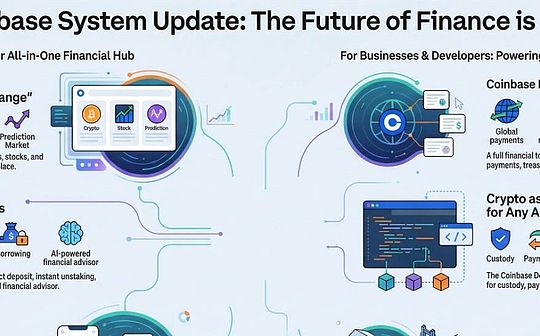
1. 1.introduction
In the past two decades, with the rise of e -commerce, the growth of social media, and the popularization of the mobile Internet, the Web2 market platform has gone through remarkable development.CraigsList was released in 1995, and connected various needs in simple and efficient lists, from community activities to housing leasing to work and service.Subsequently, the online platform giants rose rapidly, simplified the transaction process, connected the supply and demand more efficiently, and expanded rapidly in their respective fields with the network effect, replacing the many categories of Craigslist, and created through professionalism and subdivisions.New business models and services.Airbnb subverts the accommodation industry, Redfin has reshaped the real estate market, while Indeed and LinkedIn completely changed the way of job job recruitment. Every time people live in people’s life and technical upgrades, the market platform this track will always emerge.By providing the efficiency of unprecedented supply and demand links, completely changing the consumer experience, and achieving a powerful flywheel effect and a deep moat.
>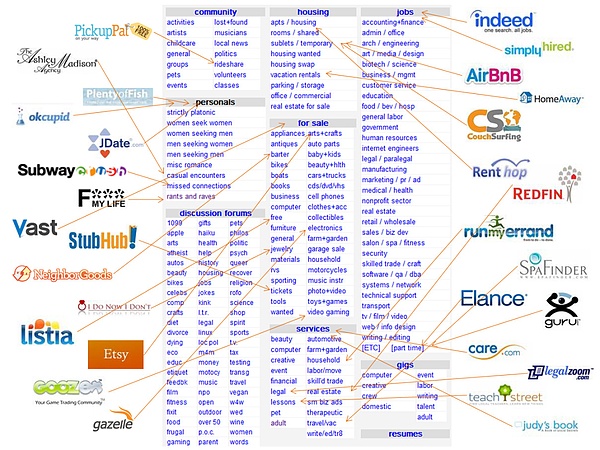
Web2 platform vs. Craigslist, souce: the gong show
However, as these web2 market platforms gradually mature, they have also begun to face increasingly obvious bottlenecks.The lack of innovation, the monopoly of the giant, the high intermediary expenses, the complex cross -border payment process, the data privacy issues, and the lack of transparency, to limit the future growth potential of these platforms.
Many platforms have paid up to 20-40%of platform costs (such as Apple’s sales of 30%of sales on all app store), which directly affects the profitability of small suppliers and weakened the needs of traditional consumers.EssenceData privacy issues have also become more prominent. In 2023, 3205 data leaks occurred in the United States, affecting millions of users.A survey shows that 73%of consumers are more concerned about their data privacy than a few years ago. 89%of consumers no longer trust brands to handle their data correctly, which has greatly reduced users’ trust in the platform.In addition, the monopoly behavior has also triggered concerns about fair competition and user rights. The centralized characteristics of the web2 market allow the platform to perform too much control to the products and services in the market.For example, Amazon is accused of abuse internal data and search results to its own brand.
In this context, the emergence of web3 technology has brought revolutionary changes.The decentralized network and tokens are expected to solve the inherent limitations of these traditional systems in the underlying supply and demand links of Marketplace.At the same time, unique technology (RWA, interoperability, reputation on the chain, and DAO, etc.) can also add icing on the cake of traditional functions and user experience, re -concept the foundation of digital business, open up new business models, and promote a new network effect.
>
2.Marketplace basically composition
For enterprises, the market platform is a comprehensive ecosystem that provides order performance and payment processing to logistics services and data analysis. For consumers, the market platform allows them to quickly browse, compare and shop from extensive goods and services.In essence, MarketPlace is an intermediary connecting the demander (terminal consumer) and the supplier (seller or supplier). By charging a certain percentage of transactions as a commission or service fee, or providing value -added services (such as payment processing, product delivery and customersSupport) charge for additional fees to achieve profitability.The core function is to access and visible. Provide sellers to access the extensive audience, and buyers can easily find a platform for the required goods.Through the efficiency of gathering supply and demand, reducing search and transaction costs, and providing certain security mechanisms, such as evaluation systems, hosting services and dispute resolution to achieve trust.
>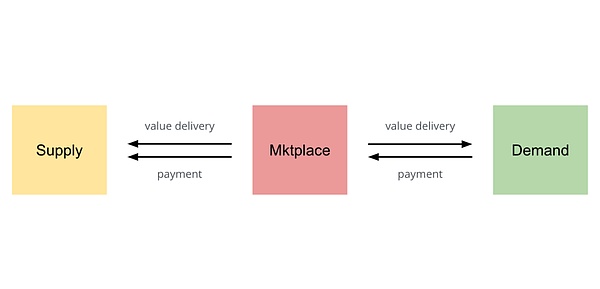
Source: linkedin
A successful Marketplace platform cannot be separated:
-
Demand liquidity:That is, the needs of buyers and sellers on the platform can quickly match and meet.High demand liquidity means that the platform can quickly respond to user needs, reduce transaction friction and wait time, and improve satisfaction.For example, Uber can find the nearest driver for passengers in a short time through its algorithm and huge driver network, so as to provide efficient travel services. DEX’s AMM mechanism provides continuous liquidity through algorithms and flow pools to make the transaction faster and convenientMore innovative mechanisms, such as Pump.fun’s Bonding CURVE, not only improve the liquidity of the market, but also ensure the dynamic adjustment of prices and the automation operation of the market, attract more users to participate in the transaction.
For buyers, high demand liquidity means less search, lower prices and better user experience; for sellers, it means higher sales, lower inventory costs, and moreGood pricing ability.The two promote the transaction activities and better returns to achieve incremental platforms.
-
>

-
For the supply side:Commodity or service providers can get token rewards by joining and contributing a platform.These tokens can appreciate and provide additional sources of income.Various DEPIN networks and other token market platforms have successfully applied this model to overcome the problem of cold start.For example, the Helium network attracts users to provide connection services for IoT devices by rewarding HNT tokens.
-
Demand side attraction:Consumers are motivated to use the platform through token awards, discounts or user loyalty plans.This not only attracted initial users, but also encouraged repeated purchase and long -term participation.For example, some DEFI platforms provide liquidity through liquidity mining and income agriculture attract users, and improve users’ participation and loyalty through token rewards.
-
Active supply:In active supply models, suppliers must continue to participate in Marketplace, and the opportunity cost of suppliers is usually high because this usually involves artificial labor and service quality.For example, Uber’s drivers need to maintain the vehicle and respond to the needs and feedback of passengers.For such platforms, token incentives can be concentrated on the demand side early, and a larger user base can be established through rewarding users’ usage platforms, thereby attracting suppliers to join.In addition, the VESTING mechanism that can design token rewards encourages suppliers to stay on the platform for a long time.
-
Passive supply:In the passive supply model, the supplier needs to be initially set up, but the subsequent maintenance cost is low, usually with high sinking costs.For example, Filecoin’s storage space providers provide storage capacity after the initial settings, and the maintenance cost is low.For such platforms, token incentives can be concentrated on the supply side first, and the supply foundation is established through rewarding suppliers with resources.Ensure that the benefits of the supplier are greater than the cost of sinking to attract more suppliers to join.
-
Desirebility: Do you need it?
-
User needs and pain points: Take the RWA/DEPIN project as an example. Does the project solve the actual use cases or problems in the field of physical infrastructure or physical assets?
-
User research: Does the founder conduct thorough user research to understand their target audience?
-
User experience: Is the platform intuitive and easy to use?Do you provide seamless purchase, sales or management asset experience?
-
Value proposition: Is the value proposition clear and powerful compared with traditional alternatives?Does it provide unique benefits such as increasing liquidity, part ownership or transparency?
-
Feasibility: Is it feasible?
-
Technical stability: Is the basic blockchain technology scalable and safe?Does the smart contract have been thoroughly audited to ensure that there are no loopholes?
-
Compliance: Is there a clear strategy to cope with the changing regulatory environment?
-
Viability: Is it continuous?
-
Business model: Is there a clear and sustainable income model?Is the design of tokens reasonable and can inspire long -term participation?
-
Market potential: Is TAM big enough?Is there a growth and expansion to the potential of new assets or markets?
-
Competitive advantage: What unique characteristics or capabilities of the project make it stand out in competition?Is there a strong network effect or a first -mover advantage?
Source: iosg s
2. Compound Nature of Demand:On a successful Marketplace platform, the increase in demand should lead to further demand growth, thereby forming a self -enhanced flywheel.When the demand on the platform increases, the trading activities that come with it must quickly stimulate the growth response of supply. This response not only improves the diversity and quality of the product, but also improves the user experience.Does the brand effect further drive the network effect, so that the overall value of the platform continues to improve.Only by efficiently realizing this flywheel effect can the MARKETPlace platform be continuously adaptable and met with the needs of users through continuous improvement and innovation, thereby maintaining long -term competitive advantages.
>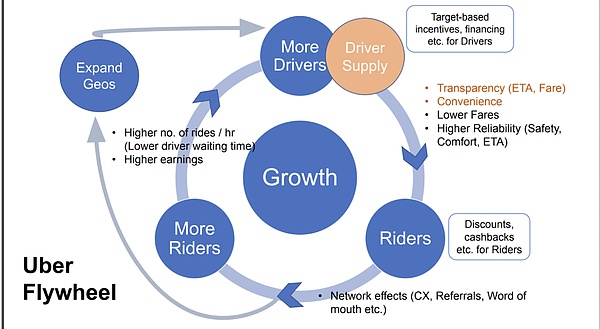
Uber compounding flywheel, source: linkedin
Taking the competition between BLUR and Opensea at that time, in addition to the advantages brought by airdrops, BLUR launched more precise PMF products for the needs of the main transaction volume contributors (professional traders) in the NFT market.It allows traders to buy high -end sweeping tools for NFT in batches, lists of multiple markets, faster trading speed and lower GAS costs, thereby improving demand liquidity.In addition, the BID Wall first launched by Blur allows users to bid in batches within a specific price range. This mechanism makes it easier for sellers to find buyers, reduce price fluctuations, and improve transaction efficiency and liquidity.Advantages, BLUR has rapidly increased the average daily sales in a short time, and now occupy the market share of 63.1%of the NFT Marketplace.Higher demand liquidity has led to further growth in demand, forming a self -enhanced flywheel effect, and consolidating Blur’s position in the market.
>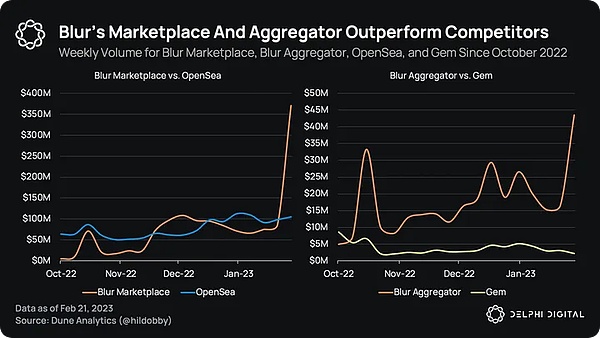
Source: Delphi Digital
>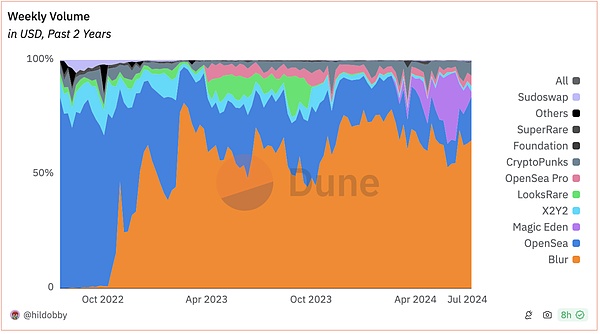
Source: dune
Optimization of supply and demand is the element of success in traditional market platforms, which is essential for our exploring the potential of web3 market platforms.How web3 technology optimizes supply and demand links and economic benefits, making it more valuable, efficient for all participants, and further innovating the operating model and economic effects of the platform is the focus of this article.
>
3..How to empower the web3
3.1Decentralization: User data control and anti -review capabilities
Traditional centralized market platforms not only have the risk of user data abuse, but also are easily controlled and reviewed.E -commerce giants such as Amazon have not only mastered the user’s shopping habits and search records, but also prioritize the recommendation of their own products and even price control through these data.The Cambridge analysis scandal similar to Facebook directly exposes the huge risk of user data being abused.In addition, in recent years, when platforms such as EBAY are dealing with disputed products released by users, they have been removed or blocked due to pressure, which has caused widespread discussion on platform review and content control.
The web3 market platform is based on the distributed node network.Reducing the dependence on a single intermediary has improved the security and anti -review capabilities, which means that users have greater control over their data.It can decide to share content and ensure that its transaction information is not affected by centralized leakage, and it is consistent with the increasing demand for data privacy and control of data. The advantage of decentralization is an important development direction of Web3 Marketplace.
Decentralized Marketplace’s previous obstacles are the user experience comparable to the traditional market. Today’s technology and macro environment have undergone tremendous changes. Layer2, cross -chain, DID, NFT, chain abstraction, etc., combined with VISA and MasterCard to start supporting support to support supportCryptocurrency payment, more and more DEFI platforms seeking compliance certification, etc., are all promoting the implementation of Mass Adpotion. The future decentralized market can shorten the gap between the traditional market to overcome the obstacles of the past and achieve a wider range of applications and more widely applications and achieve widespread application and more widely used applications.universal.
3.2 Transparency and non -tampering: Revolution in the collection market
The transparency and non -tampering of the underlying technology of the blockchain also shows huge potential in the collection and luxury markets.The technology of traceability of luxury jewelry can reduce the lengthy verification and transaction processes, making transactions more efficient and transparent.For example, Courtyard.io, which focuses on sports souvenirs and collectible card transactions, creates an irreversible digital record for each item. Through blockchain technologyAnd store in safe facilities.Each collectible is bound to a NFT (non -homogeneous tokens). Users can verify the authenticity and ownership history of items, eliminate complicated verification processes in the traditional market, and ensure the safe storage and transparent transactions of items.
3.3 Cross -border payment andGlobal
In Web2, supporting cross -border payment needs to be carried out internationally with various local systems.More than 80% of YouTube users live outside the United States.To support local currency payment in each region, the platform must be integrated with international payment gateway.Many platforms cannot cover long -tail geographical areas due to lack of resources.But web3 realizes unparalleled unparalleledness and global availability.Through the development of various capacity expansion technologies, trading costs have also been significantly reduced, reducing the threshold for participation.
3.4 Smart contract and asset logic embed
The traditional Web2 market platform has the problem of fragmentation of liquidity, which means that sellers must list and pricing products on different platforms, resulting in decentralization of liquidity, poor user experience, and often paying higher transaction costsEssenceHowever, in the web3 market platform, smart contract allows digital assets to sell, trades and display on multiple market platforms. Through this liquidity aggregation, sellers can centrally concentrate resources and sell products at more competitive prices to sell products for more competitive pricesAnd buyers can enjoy more favorable transactions.
In addition, the programmable nature of digital assets allows logic directly into assets, rather than relying on applications that control assets, and provide possibilities for innovative business models and more flexible asset management.Compared to the traditional market, the better empowerment of the commodity owner or creator.Most of today’s NFT markets are nested with such logic. For example, Blur and Zora made in NFT’s embedded version tax logic to achieve the continuous revenue flow of creators in the second sales of each time. This is in the traditional art market.It is difficult to achieve.
>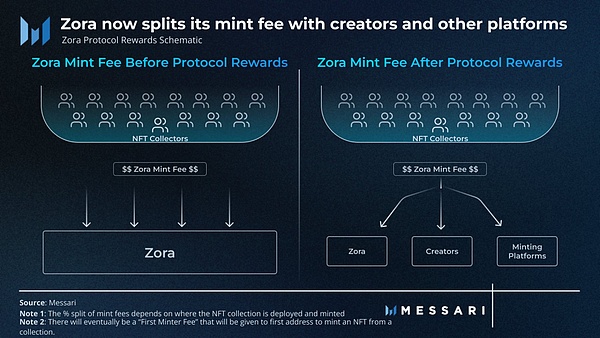
Source: Messari
3.5Token incentive mechanism and economic model
A marketing platform buyer can quickly reach the underlying substance of transactions. It is the basis for the number of buyers and sellers in the market. For traditional platforms, attracting initial users and supplying “cold start issues” is usually a major challenge. It reaches a certain scale to reach a certain scale.Before, the value of a MarketPlace platform was small.
>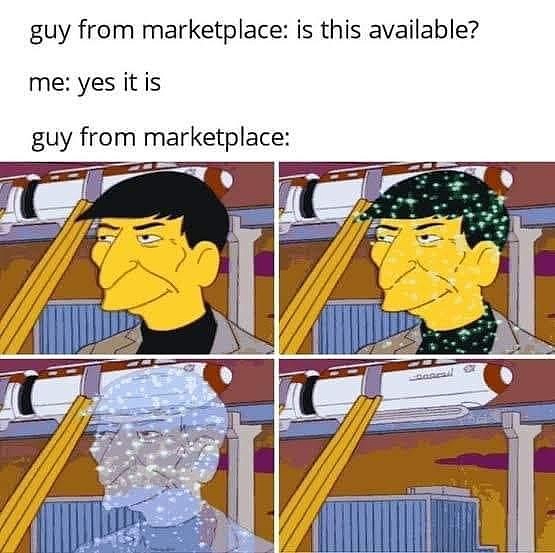
Bleak
Source: Reddit s
Traditional Marketplace usually needs huge marketing to retrieve this starting problem, but web3 technology can solve this problem through token incentives.Through the growth and value creation of the token economics platform.This “better and better” business model can reward early participants, create a self -enhancement ecosystem, and promote the growth of rapid users and suppliers.After the platform, the token economy can also be used to maintain user retention.
Different types of Marketplace can apply different tokens incentives.According to the different supply model, the project party can design a targeted incentive mechanism. Here, the two types of market definition of Mason NYSTROM articles are used to analyze:
Both markets can start through the problem of cold starting the end of the tokens.Specific implementation, the incentive mechanism not only improves the user’s participation, but also brings higher liquidity and activity to the platform, helping the platform market to solve the most difficult initial users and the challenges of the supply foundation.By designing token incentives for different supply models, the Web3 platform can achieve higher user participation and supplier activity, thereby promoting the rapid growth and long -term success of the platform.
3.6 From decentralized governance to community -oriented market
Developers can use Web3 technology to build a new market form. For example, through DAO management, the concepts of DEFI, NFT, and Yuan universe are fused to form innovative applications to enhance the transparency and fairness of the market, and enhance the user’s sense of participation and belonging.Let users directly participate in the decision -making process of Marketplace, so as to transform the platform into community -driven ecosystems.This model can attract more loyal platform stickiness, enabling MarketPlace to more flexibly adapt to the changes in user needs, expand function and attractiveness.
For example, by creating DAO and airdrop Blur, BLUR allows token holders to participate in platform governance, giving users the right to speak in key decisions. Compared with OpenSea’s centralized governance structure, Blur’s DAO governance model has better aligned users and users and users and users.The interests of the platform, the airdrop mechanism not only rewarded active users, but also gave them governance to inspire users to actively participate in the platform’s transactions and interactions to further promote market expansion.BLUR encourages specific user behavior through multi -stage gaming design, such as inspiring users to bid on the platform through integral systems, and issue rewards based on loyalty and transaction behavior.
>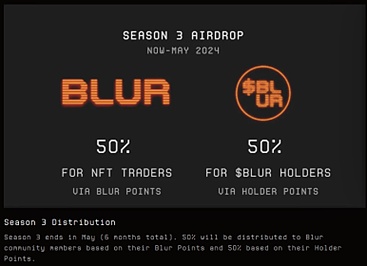
Blur Season 3 AirDrop, Source: Blur
Combined with the DAO mode, the future Web3 Marketplace can create a more open and interactive community -oriented market platform.The unprecedented successful live broadcast and cargo model we are familiar with is a successful example of this community -oriented market.We have seen social media platforms like Instagram and Tiktok used their huge user groups to create a vibrant social business center.The success of a community -driven model like WhatNot, it has become the largest online auction and live shopping platform in the United States by combining buying and selling collections, toys and other related items with content creation, interaction and sharing.This model provides a real reference for the development of the web3 market platform.
In the field of web3, similar community -oriented modes can also be applied.For example, the decentralized market creation and management tools provided by District0x allow users to easily create their own market and promote community participation and interaction.In addition, on the chain star card exchange Arena Club, the Showroom function launched by its launch allows collectors and sports stars to create a personalized virtual exhibition hall to publicize their collections to community members in the form of NFT, which enhances community interaction.Further improve transaction activity.
>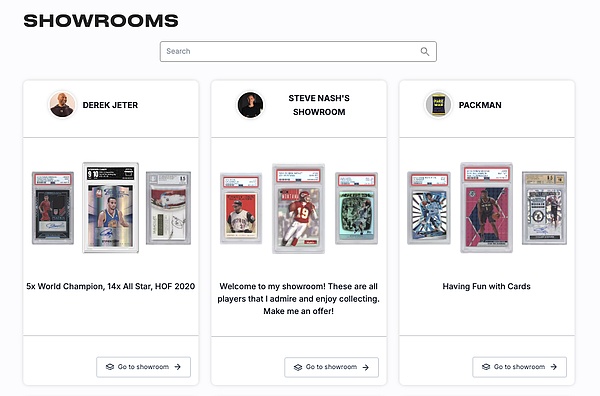
Source: ARNA Club
Through the development of SocialFi, it is expected that web3 Marketplace can better combine the user’s social interaction with trading activities in the future. Users can not only buy and sell on the platform, but also use community interaction, content creation and sharing.Increase the viscosity of the platform and user loyalty.For example, users can gain benefits in social interaction through the tokens, or establish contact with other community members through NFT display and transactions to further promote the platform’s activity and transaction frequency.
New market for 3.7 tokens
In addition to providing optimization for the existing market, web3 new technology has brought many innovative markets including data/decentralized AI markets, and the wireless network market, storage/computing resource market implemented by DEPIN. Here we discuss that it is closer to consumers, RWAThe traditional innovative transaction method brings.
As the Colin Butler of Polygon Labs says that 2024 can be called Year of tokenize, technical barriers are gradually breaking through, and traditional finance’s acceptance of Crypto is increasing.For RWA, both the volume and dimension are increasing. According to a report from Boston Consulting Group, the scale of the RWA token market in 2023 is US $ 66 trillion, and this number is expected to reach 16 in 2030$ Trillion.In the fundamental change of traditional asset management and transaction methods, RWAs are significantly expanded in quantity and asset scope.From the legal currencies, gold, real estate, to art, luxury goods, intangible assets, etc. In addition to the basic DEFI loan function, tokens are indispensable by the tokened physical assets.platform.In the future, there will be more realistic assets to achieve chain transactions, so that more asset categories can enter the market, increase the depth and breadth of the Web3 market, and give birth to new markets and financial products and business models.
The RWA market can provide better liquidity. Traded assets that are difficult to trade (such as real estate) become more easy to buy and sell through the platform through the tokenization, and the market liquidity is greatly enhanced.Platforms such as Realt allow investors to purchase tokens representing the ownership of the real estate.Let the supplier’s real estate owner can obtain more financing channels and liquidity through its assets.Investors of the demand party can participate in the real estate market at a lower cost and higher flexibility, buying and selling some real estate.
Projects for luxury tokens, such as Kettle Finance, are stored through Vaults, bring luxury goods (such as high -end watches) to the chain to create a transparent and efficient market, so that customers with investment demand do not need to handle storage and storage andLogistics is to focus on building and investing in luxury Portfolio to achieve lower cost and higher flexibility.It also allows luxury owners and merchants to obtain more financing channels and liquidity through its assets.Since its launch, Kettle FINANCE has turned to more than 340 luxury watches, which has contributed to $ 20 million in transactions and generated a loan of $ 6 million.These examples tell us that RWA Marketplace has the potential to improve market efficiency and create more value for investors, assets, or buyers and merchants.
>
4. 4..What other web3 Marketplace will there be in the future?
The potential of the web3 market platform is to provide new solutions for the pain points and bottlenecks that are difficult to solve, injecting new liquidity into the market that has tended to be old, and bringing a new business model.With the continuous development of technology and the acceleration of the trend of tokenization, the web3 market platform will expand to more consumer goods and traditional assets, produce a new market with “new demand+new supply”, and provide innovative value propositions for both supply and demand parties.
4.1 Intellectual property and patent market
Intellectual property (IP) and patents have always been assets with high value but low liquidity. Drawing on the inspiration of the Story Protocol through transforming IP into programmable digital assets. In the futureIt will provide creators with more control and income opportunities.Through the tokenization and smart contracts, creators can manage and trade their IP more efficiently, while ensuring the benefits they deserve in each transaction.Such a platform not only improves the liquidity of IP, but also enhances the transparency and security of the market. Investors can also participate in the patent market with lower thresholds, bringing new possibilities to the global creative industry.
4.2 More complicated data and computing resource markets
For developers and enterprises, the concept of decentralized market has been in the fields of data (such as Ocean Protocol), storage (such as Filecoin), computing resources (such as AETHIR), GPU (such as Render and IO.NET), and bandwidth.EssenceLearn from this law, we are expected to see more complex and high -value assets, such as AI models, AI Agents, IoT data, proprietary algorithms and code libraries, and identity verification services.The tokenization of these assets has potential to provide more flexible and efficient resource utilization and transaction methods.
4.3Energy/Environmental Assets and Using Rights Market
For traditional financial and professional investors, we have seen bonds, real estate carbon credit (Flowcarbon), and even Skytrade, allowing transactions, 500 feet above buildings) to achieve tokens.It has launched a decentralized market, bringing the advantages of decentralized ownership and instant settlement to traditional migrant assets.In the future, it is not difficult to imagine more environmental assets, renewable energy, use rights, and even agricultural and land use rights will be tokens, and it will give birth to a new market platform to achieve the liquidity of assets, automated management and global assets through Web3Transaction.
4.4 Various consumer goods and collectible markets
For consumers, there are already a large number of consumer goods and collectibles that have successfully achieved chain transactions, such as art, luxury goods, spirits, game virtual assets, and high -end shoes.These items have obtained higher liquidity and transparency through the tokenization and blockchain technology, attracting the attention of the global market.Looking forward to the future, more items such as gemstones, classic cars, sculptures and ceramics such as treasures and investment value may also be possible to achieve fragmented ownership and chain transactions through the tokenization, and further expand the scope of the digital collection market.
4.5 Personal time and professional skills service market
It is expected that there will be more mature web3 personal time/knowledge and skills market in the future. A decentralized time management Marketplace (such as Time.fun) can help users productize and maximize their time, so that ordinary people can trade, exchange exchangesOr sell their free time for various purposes, such as part -time jobs, skills learning, social activities or leisure entertainment.For example, Friend.tech allows users to interact with their influence on social networks.Let users buy and sell “shares” of other users to obtain the right to talk directly with them.This mechanism not only provides users with a new way of social interaction, but also allows influencers and creators to monetize their social influence and conduct unique and deep interaction with the audience.However, the success of such platforms depends on the development of emerging technologies and must break through the existing limitations, such as service guarantee, user trust, authentication, compliance, and standardization of skills and knowledge in order to achieve the network effect and market sizeincrease.
In any case, the excellent web3 market needs to be able to connect supply and demand efficiently. Based on this, innovative technology is flexibly used to reasonably use tokens incentives and token economies to achieve the initial customer acquisition and high expansion of the platform.Faced with a new platform that sprung up in the rain, we should pay attention to those who really use new technologies to solve real problems and pain points, rather than creating projects that cater to narrative, and consider whether the platform has a reasonable economic model sustainabilityAnd scalability.We can learn from the traditional IDEO innovation model to build an evaluation framework:
>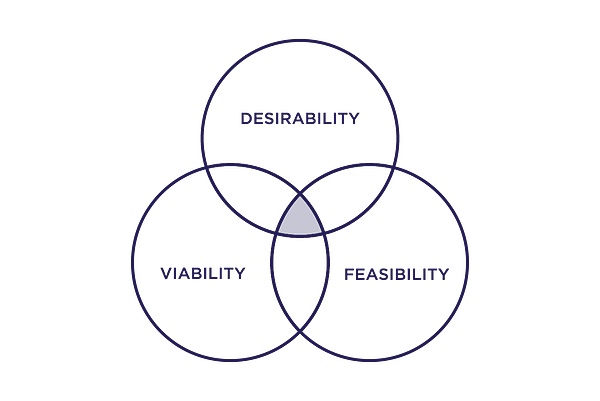
Source: IDEO
In the innovative Web3 market with high scoring, feasibility, and sustainability, it is more likely to succeed in the long run, raising today’s global digital economy to a new height.
Source:
https://www.immutable.com/blog/web3-Marketplaces-dlocking-Potential- Digital-Commerce
https://www.masonnystrom.com/p/tokenized-marketplaces-bootstrapping
https://www.coindesk.com/business/2023/11/29/2024-will-be
https://medium.com/@jennieyan000/
https://blog.variant.fund/crypto-Net-new-marketplaces


